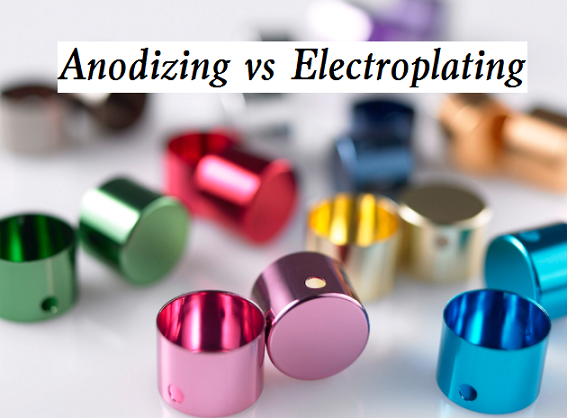Electroplating and anodizing are two excellent surface finishes for aluminum parts. While both processes are electrochemical, they differ, offering the aluminum parts unique properties that make them more resistant to damage and more durable. Choosing between electroplating and anodizing aluminum depends on the specific requirements of your project.
As mentioned earlier, both processes enhance aluminum’s properties in different ways. This article provides a comprehensive comparison of electroplating vs anodizing aluminum. We discussed each method’s features, pros, and cons to help you decide which is better suited for your needs.
Electroplating Aluminum
In simple terms, electroplating involves coating the surface of a metal with another that has better mechanical and chemical properties. During the process, a layer of metal is deposited over another – in this case, aluminum – onto a surface through an electric current. Electroplating is a typical surface finish for aluminum, as it enhances its properties and aesthetics. It also improves resistance to wear, tear, corrosion, and other environmental factors.
The aluminum part is immersed in an electrolyte solution containing metal ions, and an electric current is applied. The metal ions adhere to the aluminum surface, forming a thin, consistent coating. This technique is commonly used to improve corrosion resistance, wear resistance, and appearance.
Features of Electroplating Aluminum
As discussed above, electroplating involves coating a metal surface with another, usually with more desirable properties, to enhance the mechanical or chemical features of the final product.
Below are some of the standard features of electroplating aluminum.
- Metal Coating and Increased Thickness: Electroplating coats the surface of the aluminum part with another metal, such as nickel, chromium, or gold. This additional metal coating increases the thickness of the aluminum part.
- Uniform Coating: The process, particularly if done correctly, ensures a consistent and even layer of metal across the entire surface.
- Enhanced Appearance: Electroplating provides a shiny, polished finish that enhances the aesthetic appeal of aluminum parts.
- Versatility: Electroplating is a highly versatile finish, allowing machinists to coat aluminum surfaces with various metal options, depending on the intended use. It could enhance the metal’s aesthetics, value, or properties. For example, a gold-plated object will cost more than a typical aluminum component. Moreover, electroplating suits complex shapes and intricate designs, ensuring thorough coverage.
Pros of Electroplating Aluminum
We have already examined the features of electroplating; now, let’s discuss its benefits.
- Corrosion Resistance: Electroplating, particularly with a more resistant metal, significantly enhances the aluminum’s resistance to corrosion, making it suitable for harsh environments.
- Aesthetic Appeal: The process provides a high-quality, decorative finish that improves the visual appearance of aluminum parts.
- Increased Hardness: Electroplating adds a layer of hardness to the aluminum surface, making it more resistant to wear and tear.
- Electrical Conductivity: Certain metal coatings, like gold or silver, enhance the electrical conductivity of aluminum components.
- Versatility in Applications: Electroplating is used in various industries, from automotive to electronics, due to its ability to coat complex geometries.
Cons of Electroplating Aluminum
Below are the shortcomings of electroplating aluminum.
- Increased Cost: Electroplating can be expensive, especially when using precious metals like gold or silver.
- Environmental Concerns: The process involves hazardous chemicals and requires proper disposal and controls.
- Thickness Limitations: The metal coating is typically thin, which may not be suitable for applications requiring thicker layers.
- Preparation Time: The aluminum surface must be meticulously cleaned and prepared before electroplating, increasing the overall processing time.
Anodizing Aluminum
Like electroplating, anodizing is an electrochemical process; however, they differ. In anodizing, the aim is to coat the aluminum surface with its oxide, which is usually more durable, corrosion-resistant, and aesthetically pleasing. Therefore, anodizing enhances the metal’s properties by coating its natural oxide.
The process involves immersing the aluminum part in an electrolyte bath and passing an electric current through it. This results in a controlled oxidation process that thickens the natural oxide layer, providing various functional and decorative benefits.
Features of Anodizing Aluminum
Anodizing and electroplating share some chemical and mechanical features. Below, we explore the standard features of anodizing aluminum parts.
- Enhanced Surface Finish: The anodizing process creates a thick, hard oxide layer on the surface of aluminum, improving its durability.
- Corrosion Resistance: Anodized aluminum exhibits excellent corrosion resistance, extending the component’s lifespan.
- Allows Different Color Variety: The porous nature of the anodized layer allows for dyeing or painting, providing a range of color options for aesthetic purposes.
- Non-Conductive: Unlike electroplating, anodizing reduces the conductive properties of aluminum. The anodized surface is electrically insulating, which can benefit specific applications.
- Environmentally Friendly: Anodizing is generally considered an environmentally friendly process as it uses non-toxic chemicals and produces minimal waste.
Pros of Anodizing Aluminum
Below are some of the advantages of anodizing aluminum components.
- Improved Durability: The anodized layer significantly enhances the surface’s hardness, making it resistant to scratches and wear.
- Improved Corrosion Resistance: The anodized oxide layer protects against corrosion, particularly in harsh environments.
- Aesthetic Flexibility: The process allows for various color finishes through dyeing, offering functional and decorative options.
- Maintenance-Free: Anodized surfaces are easy to clean and require minimal maintenance, making them ideal for various applications.
- Environmentally Friendly: Anodizing is significantly more environmentally friendly than electroplating. The anodizing process uses non-toxic chemicals.
- Improved Adhesion: Anodized surfaces provide better adhesion for paints and other coatings, enhancing their longevity and performance.
Cons of Anodizing Aluminum
The downsides to anodizing include the following.
- Limited Thickness: Like in electroplating, the anodized layer is relatively thin and may not provide sufficient protection in highly abrasive environments.
- Non-Conductive Surface: While this can be an advantage in some applications, it is a disadvantage where electrical conductivity is required.
- Potential for Color Fading: Anodized colors can fade over time, particularly upon exposure to UV light and harsh weather conditions.
Key Factors to Consider When Opt Anodizing Over Electroplating
When choosing between anodizing and electroplating for aluminum, several vital factors make anodizing a more favorable option in many applications. Here’s a comprehensive look at these factors:
Corrosion Resistance
Anodizing enhances the corrosion resistance of aluminum by creating a thick, protective oxide layer on its surface. This layer shields the aluminum from environmental factors such as moisture, salt, and pollutants, which can cause corrosion. While electroplating can also provide some corrosion resistance, anodizing is generally more effective, especially in harsh environments. Moreover, the corrosion resistance of electroplating depends on that of the depositing metal. This makes anodizing particularly suitable for outdoor applications, marine environments, and areas with high humidity or chemical exposure.
Surface Hardness and Durability
Anodizing improves the surface hardness of aluminum, making it more resistant to scratches, abrasion, and wear. The anodized layer is integral to the aluminum, more or less an extra aluminum layer, meaning it cannot peel or flake off as electroplated coatings can. This durability is crucial for applications where the material is subjected to physical stress, such as architectural components, automotive parts, and consumer electronics.
Aesthetic Versatility
The anodizing process allows for adding various dyes, offering multiple colors and finishes. The porous nature of the anodized layer enables it to absorb dyes uniformly, resulting in vibrant and long-lasting colors. This aesthetic versatility is advantageous for products where appearance is essential, such as in consumer goods, interior design elements, and decorative architectural features. Conversely, electroplating is typically limited to metallic finishes and does not offer the same range of color options.
Environmental Impact
Anodizing is generally considered to be an environmentally friendly process. It uses non-toxic chemicals, produces minimal waste, and the anodized layer is non-hazardous. In contrast, electroplating often involves the use of hazardous substances, such as cyanide and heavy metals, which can pose significant environmental and health risks. The anodizing process also consumes less energy than electroplating, making it a more sustainable choice for environmentally conscious manufacturers.
Maintenance and Longevity
Another important advantage of anodized aluminum over electroplating is the easy maintenance measures required, requiring minimal cleaning to keep them looking new. The anodized layer is resistant to fingerprints, stains, and other contaminants, which makes it ideal for high-traffic areas and products that require frequent handling. Additionally, anodized coatings do not deteriorate or degrade over time, ensuring the longevity of the finish. Electroplated surfaces, however, can wear away or tarnish over time, necessitating more frequent maintenance and potential re-coating.
Adhesion of Subsequent Coatings
The porous structure of the anodized layer provides an excellent surface for the adhesion of subsequent coatings, such as paints, sealants, or adhesives. This feature is particularly beneficial in applications requiring additional protective or decorative layers. The superior adhesion helps ensure that these coatings remain firmly attached, enhancing the overall durability and appearance of the finished product. Electroplating offers a different level of adhesion for subsequent coatings, which can limit its use in specific applications.
Cost-Effectiveness for Large Production Runs
For large production runs, anodizing can be more cost-effective than electroplating. The setup costs for anodizing are generally lower, and the process can be more easily scaled for mass production. Additionally, the durability and longevity of the anodized finish mean fewer replacements and maintenance costs over the product’s lifetime, providing better long-term value.
Conclusion
Your choice of whether to electroplate or anodize aluminum should be based on the part’s specific application requirements. Electroplating processes offer enhanced appearance, corrosion resistance, and increased durability. However, you must carefully examine their properties to make an informed choice that best suits your project’s goals and constraints.




